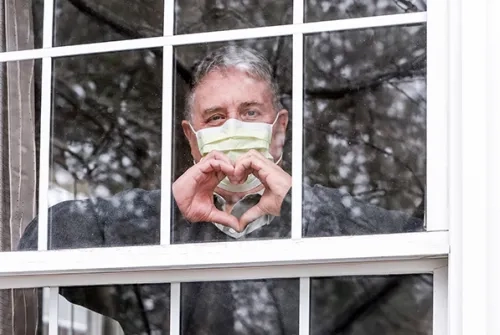Alo Yeditepe
Alo Yeditepe
Why Are the Elderly at Risk for Coronavirus?
The elderly are in first place in terms of the risk factors for Covid-19 infection. Internal Medicine Specialist Prof. Dr. Yaşar Küçükardalı reminded that people over the age of 65 may experience functional losses even if there is no accompanying chronic disease and said that these losses with age make the person vulnerable to diseases.
In our country, people over the age of 65, who have spent this process at home due to the curfew, are in the risk group for Covid-19 infection. Again, since there may be a risk of contact in areas such as senior centers and nursing homes, which are the areas where this age group lives together, the risk may increase. However, Yeditepe University Kozyatağı Hospital Internal Medicine Specialist Prof. Dr. Yaşar Küçükardalı said that the picture is quite good in this sense in our country, and stated, “Thankfully, no negative news about 36 thousand elderly people living in senior centers and nursing homes in our country has come out so far. This shows us that our elderly people are carefully cared for in private senior centers and nursing homes of both the public and foundations. Perhaps one of the reasons for this is that most of our elderly people have social security and are easily admitted to hospitals in case of any health problem, within the scope of state assurance.”
"Biological Age Is Important"
Providing information about the course of Covid-19 in the elderly, Prof. Dr. Küçükardalı pointed out that the most important factor at this point is the biological age of the person rather than the chronological age, and said:
“Aging is actually a physiological process. As we age, anatomical, functional, and biological losses occur partially in our organs and systems. However, it should not be forgotten that physiological aging does not make a person dependent on another person and old age is a relative condition. Some are 80 years old, but as healthy as a 50-year-old person, while others are 50 years old and their body is worn out like an 80-year-old. Therefore, one should not get too fixated on chronological age. What matters is biological age.”
Functional Loss in People Over the Age of 65
In the chronological age assessment, the age of 65 is accepted as the limit. Ages between 65-75 are called "youngest-old", those between 75-85 are called "middle-old", and those over 85 are called "oldest-old". According to the information given by Prof. Dr. Yaşar Küçükardalı, even if there is no accompanying chronic disease in people over the age of 65, both functional losses are experienced, and the immune system is weakened. Both natural immunity and acquired immunity weaken with age. Less exposure to the sun, inability to eat a balanced diet for various reasons, decrease in the number of immune cells, and aging play a role in this.
Functional Losses Make the Elderly Vulnerable
Yeditepe University Hospital Internal Medicine Specialist Prof. Dr. Yaşar Küçükardalı, who summarized the features that make elderly individuals riskier in the Covid-19 pandemic, primarily as having chronic diseases, biological aging, and weakening of the immune system, continued his words as follows:
“The lymphocyte count of a 40-year-old person is not the same as that of an 80-year-old person. Again, the natural immunity of a 40-year-old individual and an 80-year-old individual, that is, the body's capacity to fight microorganisms, is not the same. It is natural for functional losses to occur with advancing age. For example, the filtering capacity of our kidneys decreases by 1 ml per year after the age of 40. Normally, this rate is 120 ml per minute. However, it cannot be expected to be 120 ml in an 80-year-old individual. Therefore, functional losses that occur with advancing age can make the person sensitive. Because of these effects, the risk of getting diseases increases in elderly people. The sum of functional losses experienced in organs and systems in the elderly does not increase mathematically but rather shows an accelerated increase. The overall effect is much greater than expected. We can exemplify as follows:
In an elderly person whose blood pressure drops slightly below normal, clouding of consciousness and loss of balance are observed, the risk of falling increases, the possibility of fracture is high because there is bone loss, the healing period of the fracture is long, and the long bedtime increases the risk of pressure ulcers. In this way, a domino effect is observed.”
About
Faculty and Year of Graduation:
Medical Faculty of GATA, 1987
”
See Also
- What is Hypoglycemia?
- Dealing Ways with Overtemps
- 8 Causes of Sweating
- Dehydration can Lead to Forgetfulness in the Elderly
- Sweating May Be a Sign of Illness
- What is HCT (Hematocrit)?
- Misconceptions About Hypertension
- What is Hypertension?
- Latent Diabetes (Prediabetes)
- An Infection that Does Not Recover is a Precursor of Diabetes
- 'Exercise Vaccine' Recommendation for Chronic Fatigue
- Eating Calories In The Morning Saves Lives
- The Warrior That Protects Our Immune System: Vitamin D
- The Immune System and Sleep Are Sending Messages to Each Other for A Healthy Life
- Eye, Kidney, and Heart Enemy: Hypertension
- Vitamin D May Be the Cause of Your Fatigue
- Benefits of Antioxidant
- Start the New Year Healthy
- Multivitamin is Not a Panacea
- Do I Have Covid or Influenza?
- The Amount of Nutrients Needed for Satiety Decreases as Eating Time Increases!
- Health Problems Triggered After Recovery from Covid
- Check-ups Following the Vacations!
- Methods to Deal with Bad Cholesterol
- Not Every Sore Throat Is Caused by an Infection!
- Why Is Vitamin D Deficiency So Common in Türkiye?
- Aspirin Used Without Physician's Advice Increases Risk of Bleeding!
- Do Not Unconsciously Turn to Herbal Products to Get Rid of Winter Fatigue
- Check Up for Females Over 40
- Check Up for Females Under 40
- Check Up for Females Over 50
- Check Up for Males Under 40
- Check Up for Males Over 40
- Check Up for Males Over 50
- Cardiology Check-Up
- Child Check Up Package
- Psychologist Package
- Dietitian Package
- Check Up Packs
- Healthy Aging Course
- Comprehensive Geriatric Assessment
- How to Drink Water: Warm, Cold, or Hot?
- Symptoms of Vitamin D Deficiency
- Misconceptions about Cholesterol!
Alo Yeditepe





